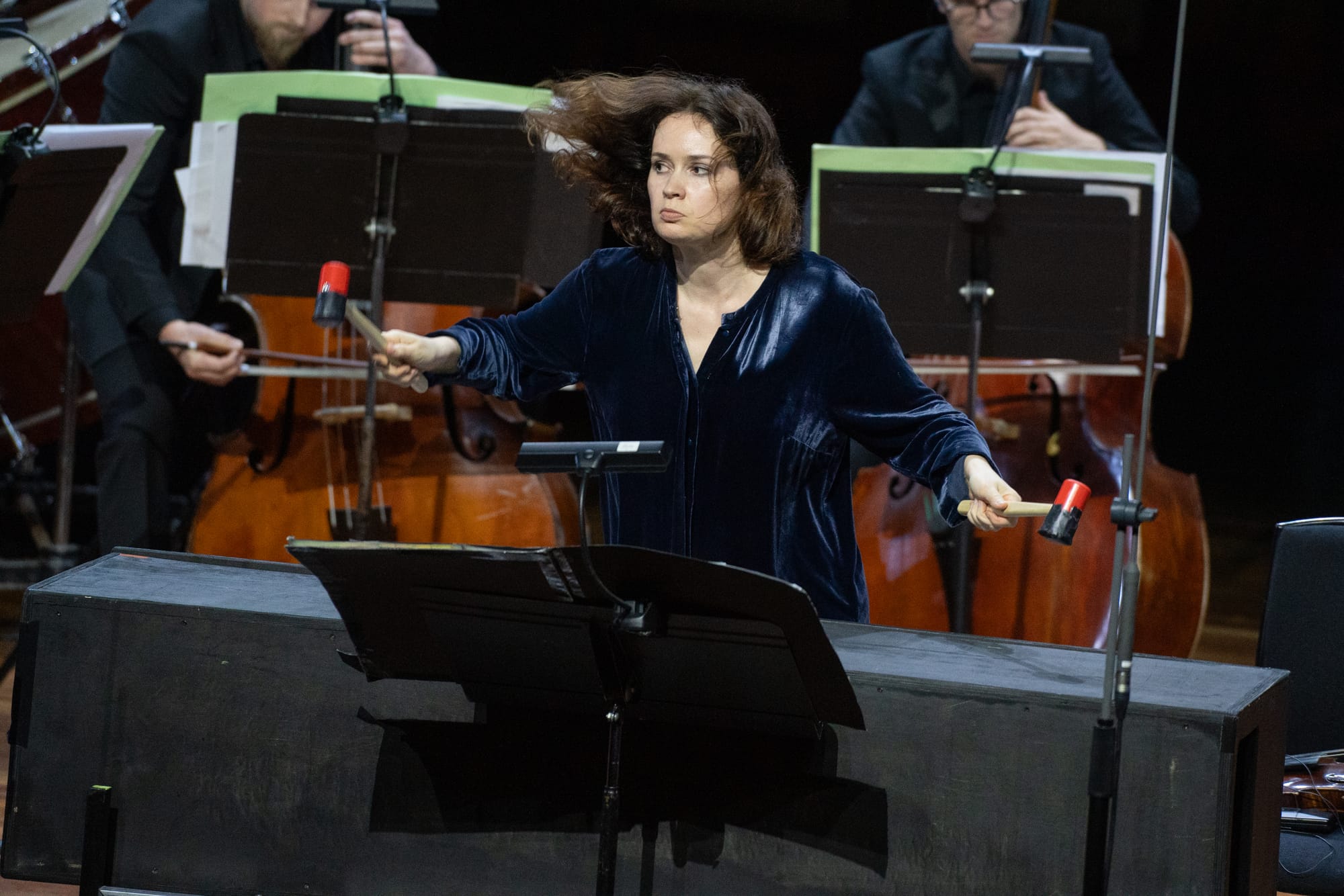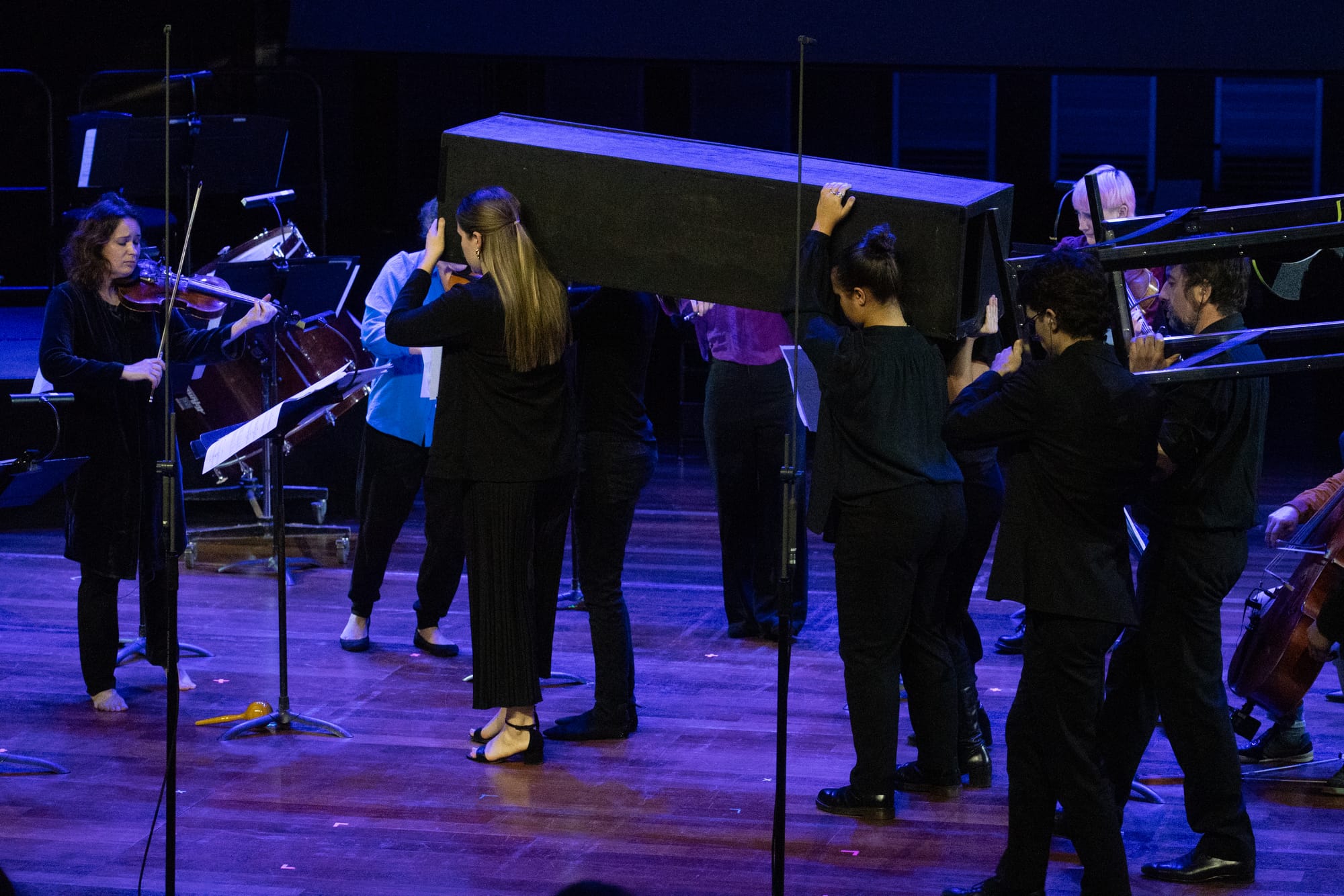
In response to Patricia Kopatchinskaja stunning Schonberg Concerto earlier this week at the Proms, we republish a report on a concert at London’s Queen Elizabeth Hall:
Patricia Kopatchinskaja’s programming is always stimulating, but as she turns her attention to environmental issues and climate change, so her events take on an extra power. Her last QEH concert I reported on was Schoenberg’s Pierrot Lunaire in a remarkable realisation, while her “Les Adieux” – Music for the Planet at Gstaad in August last year was transformative to many. Never one to compromise, the performance included a part for the ancient carnyx (used by the Celts during the Iron Age!) and a visceral realisation of humanity’s current trajectory.
And here, with Aurora Orchestra and Voices joining Kopatchinskaja, is the end-point. The “Dies iræ” (Day of Wrath) is a well known track of the Mass, but it is also a terrifying painting of end-times. Kopatchinskaja’s juxtapositions have, too, always been remarkable and here, after Giacinto Scelsi’s Okanagon formed the “entrance music,”, Battaglia by Heinrich Biber (1644-1704) rubbed shoulders with Black Angels by George Crumb (1923-2022). The excellent keyboardist Michael Wendeberg joined Auira x2 and Kopatchinskaja, performing on piano, Orhan and harpsichord at various points.
As you can hear, Okanagon (1968, for harp, double-bass and tam-tam) is a sort of black processional, with the soul of the instruments skewed into otherworldliness. Here’s a performance by College New Music:
The sheer extravagance of the performance of the movements from Biber’s Battaglia à 10 from Aurora Orchestra, led by Kopatchinskaja with huge verve, was remarkable. The dissonances of Biber’s “Die liederliche Gesellschaft von allerrey Humor” seemed only a hop, skip and a jump away from Crumb’s apocalyptic visions. Here, in absentia Kopatchinskaja, is Jordi Sacall’s fine version on Alia Vox (Savall’s entire performance is a miracle, incidentally):
But Savall doesn’t have the juxtaposition of Crumb. And how Crumb’s music took Biber’s imagination a step further. The term Black Angels is for many a contradiction (occultists will disagree), and Crumb’s score is often like a Rothko painting of black on black. Here’s the first excerpt Kopatchinskaja and Aurora played, “Sounds of bones and flutes,” in a performance by the Cikada Quartet (well named if you know the very opening of Black Angels!):
Juxtaposing the wild violin dance of “Der Mars” (Biber), superbly played by Kopatchinskaja, with Crumb’s “Danse macabre” was perfect, especially given the inconclusive ending of the Biber; and yes, that’s the “Dies irae” all over the latter!:
It was not all straightforward alternation such as this; a recording and video fo Jimi Hendrix felt perfectly at home next to the forward-looking minds of both Biber and Crumb,. And whilst the Crumb pieces included both “Devil-music” and “God-music,” perhaps it was the final “Threnody II” and PatKop’s frenzied Die Wut (The Rage, for string ensemble) that spoke most cogently and eloquently. Aurora Orchestra is itself a ground-breaking ensemble, but never have I heard them quite so unbuttoned. You can find a performance of the PatKop at this link on the Harrison Parrott website, or here’s a YouTube with the composer and Camerata Bern:
The Aurora Voices were literally sitting amongst the audience for a performance of Lotti’s remarkable Crucifixus a 10, a piece of blisteringly beautiful dissonances. Here’s Peter Phillips and The Tallis Scholars:
Improvisation is a notable and indispensable part of Kopatchinskaja’s events, and here one led to Dowland’s Lachrimae antiquae novae from that composer’s 1604 masterpiece, Lachrymae, or Seven Teares:
The music of Galinea Ustvolskaya is utterly uncompromising. At 20 minutes, her Composition No. 2 (Dies Irae), scored for eight double-basses, percussion and piano is harrowing listening. A box is hammered (one hammer in each hand) by the percussionist, here Kopatshinskaja. Even more bleaky, the coffin-shaped box was carried on in the manner of a funerary procession with its stand just behind it. Hammering on the coffins of the dead to awaken them, perhaps, seen against a projection fog ray, mottled, dry earth.

A call-to-arms to humanity before it is too late, it ceded to, perhaps, the only music it could, the plainchant for the “Dies irae”. Here’s that plainchant, sung “straight” by Aurora Surgit on their Naxos disc, Ego sum resurrectio: Gregorian Chant for the Dead:
The difference at Southbank Centre was what sounded initially like a lot of “clicking”: metronomes, held by the members of Aurora Voices (spread out around the auditorium) all running at different times, and all running out. Highly symbolic, and perhaps a reference too to Ligeti’s Poème symphonique for 100 metronomes. As the ticking quieted, what remained was total, stunned silence.
The audience reaction was enthusiastic: these emotions hit hard and run deep.
Here is the entire concert in its SWR (South German Radio) performance at the Konzerthaus Freiburg. The Southbank event was on Wednesday, February 21; on Monday, the same forces perform this programme in Vienna. Unforgettable.
The link to the concert programme for the QEH concert can be found here.
Photos © Pete Woodhead
The Amazon link to the Savall Biber disc for purchase is here; that to his Dowland Seven Teares is here. Unfortunately, the Cala Crumb is rather expensive (link); as is the stunning Kronos version (link). The Naxos Ego Sum Resurrectio is here, and the Savall Dowland here. Selected Spotifies below, but if you happen to be in Vienna …




